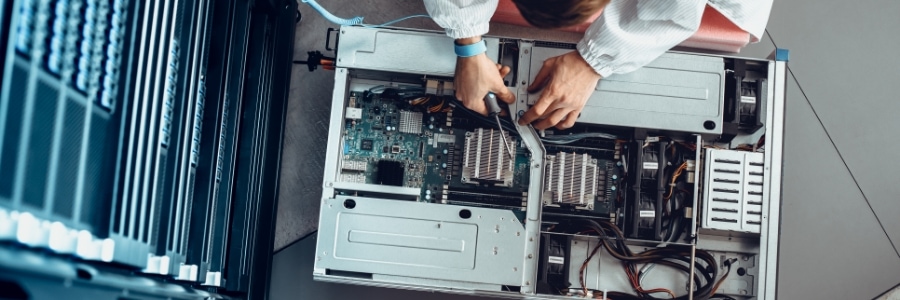When you first start using a new computer, or really any new piece of IT hardware, it feels snappy and responsive. The performance is lightning-fast, and it feels like nothing could ever slow it down. But as time goes on, more advanced models hit the market, and what once felt like cutting-edge technology begins feeling “laggy.” Your once-reliable system starts slowing down, causing your productivity to fall.
So, how long should your hardware last? And when it is time to replace it?
What is the average lifespan of IT hardware?
Just like any other piece of equipment, IT hardware has a finite lifespan. Even the best devices eventually age out of their prime, and recognizing the signs can save you from unexpected downtime or costly repairs. Typically, business-grade hardware such as servers, desktops, and laptops have an average lifespan of about 3–5 years.
However, this may vary based on the hardware model, how often it's used, and how well it's maintained. For example, a high-end workstation can last up to seven years or more with proactive maintenance, cleaning, and component upgrades. Nevertheless, knowing the general lifespan and warranty period of your hardware can help you plan and budget for replacements.
Signs it's time to replace your hardware
Before your outdated hardware gets to the point where it's causing major disruptions and hindering operations, look out for these signs that indicate it's time for an upgrade:
Slow and unreliable performance
One of the first signs that your hardware is nearing the end of its life cycle is a noticeable drop in performance. Programs that once ran smoothly now take longer to load, multitasking becomes sluggish, and overall system responsiveness deteriorates. This isn’t just frustrating; it can severely impact productivity. If your hardware can’t keep up with your daily tasks, you’re overdue for an upgrade.
Inability to run supported operating system versions
Both Microsoft and Apple provide security updates and support for their operating systems only on supported hardware. Many organizations are unprepared for the upcoming end of Windows 10 support that Microsoft has announced, which will end in October 2025. Microsoft offers a free upgrade to Windows 11, but only on hardware that is running more recent generations of processors and on systems that have dedicated security chips (Trusted Platform Module 2.0). If your hardware is older, it may not be able to be upgraded to Windows 11. If any of your Windows PCs are more than 6-7 years old, it is time to budget for replacements before the October 2025 end-of-support for Windows 10.
Frequent crashes
System errors, freezes, or blue screens of death could be caused by various factors. Incompatible software, malware infections, and outdated drivers are just a few examples. But if you've ruled out these factors and the crashes persist, it's likely an indication that your hardware is on its last legs. Outdated hardware is often unable to cope with the increasing demands of modern software and operating systems, leading to frequent system crashes. While troubleshooting and repairs might offer temporary relief, this doesn't address the root cause and the problems may persist until the hardware is replaced.
Noisy or overheating components
As hardware ages, cooling systems can become less effective, leading to increased noise levels and overheating. Fans may run louder as they struggle to keep up and dust may affect proper heat dissipation. When left unchecked, overheating can cause damage to internal components, which can lead to system failure or instability. If you notice your hardware is running hotter than usual or making unusual noises, it's a sign that they're working harder than they should be and need to be replaced or serviced.
Physical damage
Physical wear and tear is inevitable over time, especially if you carry around your laptop or use your desktop daily. This can manifest in various forms such as cracked screens, broken keyboards, and damaged ports. While some of these issues are superficial and can be easily repaired, there are some damages that are simply not worth fixing, especially if the device is already close to its end of life. Fried internal components and severe water damage can make the hardware beyond repair. If your hardware has reached this point, it's time to replace it with new and more reliable equipment.
Insufficient computing resources
Software and operating systems get updated over time and typically require more hardware resources (e.g., processing speed, RAM, and storage space) to run smoothly. While cloud solutions can offset some of computing demands on your hardware, eventually your aging hardware will no longer meet the minimum requirements of these newer software and tools. This can not only slow down your operations but also leave you unable to take advantage of the latest features and technologies.
Repair costs exceeding price of replacement
From a financial perspective, repairing old IT hardware is not always the most cost-effective option. While it may seem cheaper at the moment, constantly fixing problems and replacing parts can add up quickly, especially when you factor in loss of productivity and the labor costs involved with troubleshooting and repairing equipment. If the total cost of repairs are close to or exceed the replacement cost, then it's time to let go of your old hardware and invest in more up-to-date equipment.
Waiting until your hardware is completely unusable may seem like prolonging an investment, but it can ultimately cause more harm than good. Knowing when to replace your IT hardware can save you a lot of money and help you stay competitive in the long run.
If you need help selecting and acquiring new hardware, Fidelis can give you professional recommendations along with the best deals on high-quality equipment. Contact our consultants today to get efficient IT solutions that meet your unique needs.

